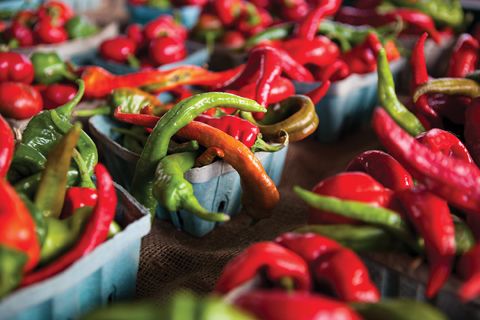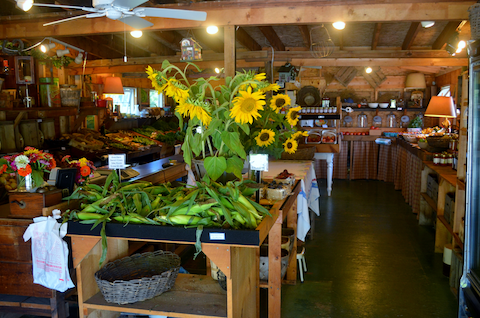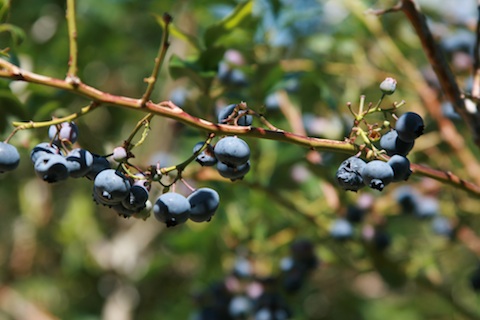
Above: Hot peppers come by the pint or the peck at Shaul Farms in Middleburgh. Photo by Richard A. Smith.
Buying Catskills foods year-round is like being on a 12-month-long scavenger hunt. One farmstand has the heartiest greens and another specializes in heirloom tomato varieties.
The best eggs, the ones with the golden-orange yolks, are at yet another stand. The tastiest veal is sold off the front porch of a farmer in the next town, and the mind-blowing raspberries are hidden in a humble greenhouse a few miles in the other direction.
There are many ways to buy Catskills food, from visiting the nearest farmers’ market to arranging to purchase a quarter of a cow months in advance. It’s more complicated than shopping at the supermarket. But the groceries you bring home are fresher, tastier, and often, if you know where to look, cheaper.
You’re not the only one who benefits from eating locally. The Catskills’ small, family-owned farms share a rich agricultural history but have been largely bypassed by today’s modern food system. By eating locally, you support countless mom-and-pops and their small-scale crop and animal-husbandry practices, which are generally more humane and ecologically sound than those of industrial farms. You cut the energy it takes to transport your food and keep dollars in your community. You get to meet, face to face, the people and animals who nourish your family.
Did we mention it’s delicious? Once you eat an egg with a golden yolk or a clove of fresh-grown garlic, you’ll never go back to factory food.
Below is our guide to your Catskills food scavenger hunt, starting with buying local for beginners and building up to the techniques of advanced practitioners. Enjoy gathering—and eating—your provisions.
Hit the Farmers' Market
The first thing a Catskills food newcomer should do is visit the nearest community farmers’ market. That’s the place to meet farmers and get a sense of their seasonal offerings. The food is fresh, often harvested days or mere hours beforehand, and your money goes straight to the farmer, not a middleman.
“Freshness is my primary goal,” said Madalyn Warren, a farmer who runs Straight Out of the Farm in Roxbury and sells her food at the Pakatakan Farmers’ Market. “I don’t have the setup to store things for a long period of time, or to refrigerate it for a long period of time. My way, it’s out of the ground and into your hands.”
There are dozens of Catskills farmers’ markets. Most are seasonal; some operate year-round. The Catskills Food Guide is partnering with Pure Catskills to track farmers’ markets; click here to search the Pure Catskills farmers' market database.
Go prepared, with sturdy tote bags in hand and a cooler in the car if you’re traveling a long way home in hot weather. Stuff your wallet with small bills; don’t assume vendors will accept credit cards. (Many markets do honor vouchers from food-assistance programs, though.) Go on the early side—most of the good stuff will be picked over by closing time.
The downside of farmers’ markets is that they’re only open for a limited number of hours a week, and many of them close during the cold months. So if you have a desperate need for grass-fed beef and you missed the market, you’re out of luck until next week (or maybe next spring).

Above: A small farmstand in Margaretville specializes in garlic. Photo by Jennifer Strom.
Stop by the Side of the Road
Catskills roadside farmstands can be as simple as an unstaffed lean-to arrayed with garlic, or as sophisticated as a year-round, weatherproof operation.
Migliorelli Farm opened a farmstand on Route 28 in Mount Tremper in 2012. the Migliorelli family grows 150 varieties of fruits and vegetables on their farm in tivoli. They sell their wares at the Ulster County location and two other full-time farmstands across the Hudson River, and at an astonishing 30 farmers’ markets throughout the Hudson Valley and New York City.

Above: Migliorelli Farm’s large stand in Mount Tremper carries a wide variety of seasonal produce. Photo by James Veith, submitted to our 2013 Catskills Farm Photo Contest.
The Migliorelli in charge of the Mount Tremper farmstand is Mary Ann Rosolen, a former food scientist for Kraft who got involved in her brother’s family farm by developing value-added products based on the farm’s produce, such as tomato sauce, applesauce and bloody mary mix. She’s since become committed to expanding the stand into a one-stop shop for local-food consumers. She carries Catskills and Hudson Valley beef, lamb, chicken, bread, cheese, yogurt, eggs, produce, preserves, venison and gelato. In the winter of 2013-14, the farmstand will be open daily except for Thanksgiving and Christmas and will stay open until 8 p.m. on Fridays.
“We want to catch the weekend people. Our name is familiar to them because they shop our farm markets in the city,” she said. “Now they know that they don’t have to schlep their groceries up for the weekend.” Most roadside stands are less established, and are often the work of solo farmers whose best customers live within a few miles and pass by on their way to and from home every day. Most towns in the Catskills have a few stands sprinkled around their outskirts. The best way to find them is to keep an eye out for the signs; the less fancy the sign, the better.
Head to Main Street
Retail stores specializing in local foods have appeared on main streets across the Catskills. Some are modern natural food stores with a mix of local and more far-flung foodstuffs, while others are housed in historic general stores.
Just outside of Kingston in Ulster County, Adams Fairacre Farms offers a large selection of local goods along with national brands at its “super farm market.” One of the early pioneers of locavore groceries, Adams Fairacre Farms originated from an actual farmstand run by the Adams family in Poughkeepsie in the early 1900s. The Kingston store, the second of four, opened in 1981.
Go to the Source
You can’t get any more local than buying food straight from the farm.
“On-farm sales are great,” said Nicole Day Gray, who runs AgriForaging Inc., a consulting company that helps Catskills farmers expand their markets. “That’s where farmers capture some extra income.”
Some, like Heather Ridge Farm in Preston Hollow and Root ’n’ Roost Farm in White Sulphur Springs, maintain fully stocked stores with a wide array of offerings. Others specialize in a few select items. For example, Byebrook Farm in Bloomville bottles fresh raw milk every day for buyers who pull it out of a roadside fridge and pay on the honor system.
Sometimes, you need to go to the farmer’s door. Crystal Brook Farm in New Kingston stocks a freezer on its farmhouse porch full of farm-raised veal. Press the big button to let the Elliott family know you’re there to buy.
“It’s not like you’re going to the grocery store,” said Andrea Elliott, one of the owners. “You’re at someone’s home, but you don’t have to feel intimidated. Most farmers are friendly.”
It can be intimidating to drive up a winding dirt road to a farmer’s front door to buy eggs, milk or meat, but don’t be shy.
“Farmers want you to come,” says Day Gray. ”If there’s a sign that says ‘Fresh Eggs,’ go there. That’s an invitation.”
There are a few ground rules. Visit during normal business hours. Stay away from the animals. (They’re not all friendly, especially that ornery bull in the back field.) Don’t honk. Ask permission before taking photos or touring around, and keep your kids and dogs in the car. Bring small bills, and if there’s an honor system or an unattended cash box, wait on yourself.

Above: Pick your own blueberries at Blue Sky Farm & Winery in Stamford. Photo by Jennifer Strom.
Buy in Bulk, Including Picking Your Own
Once you buy your food locally, you might want to buy a lot of it. Buying large quantities of produce in season is a great way to lower its cost. You face the problem of storing your bounty once you buy it, but those with a yen for preserving or stocking up a root cellar can get a car full of veggies or fruits on the cheap. In the Schoharie Valley, a wide, fertile river bottom on the northern edge of the Catskills, two farms, Shaul Farms and Barber's Farm, grow produce on a mass scale and sell it at farmstands a few miles apart from each other right on Route 30 just south of Middleburgh. They both sell in bulk, making them a destination for home canners seeking ingredients by the bushel at reasonable prices.
Harvesting produce yourself makes it even more affordable, and is a fun way to teach children about where their meals originate. U-pick farms abound in the Catskills, especially for strawberries, blueberries, apples and pumpkins. Check out our online Catskills Food database or pickyourown.org for options.
You can buy meat in bulk, too, by contacting a farmer or a slaughterhouse directly to order pork, beef, or poultry by the whole, half or quarter, often before the animal is slaughtered. Stay tuned to our Catskills Food section for a "How to Buy Local Meat" article, coming soon.
Subscribe to a Farmer’s Harvest
You can also buy your food in bulk over time, via a system known as community- supported agriculture (CSA).
The idea is simple: CSA members pay a flat rate to a farmer in exchange for a share of the farm’s bounty. Subscribers receive a fresh box of farm products throughout the growing season, usually weekly. The classic CSA is a vegetable share, but some farmers also do meat, poultry, cheese, eggs and maple syrup as well. Stoneledge Farm in Leeds is one of the oldest Catskills CSA farms, founded in 1996 and supplying members in New York City, the Hudson Valley and Connecticut. A family-run operation focusing on vegetables, Stoneledge has partnered with other Catskills farms to offer its CSA members twists on the classic CSA, including a mushroom share, a fruit share and even a coffee share, featuring shade-grown beans purchased at fair-trade prices from Central American farmers.
Greenane Farms in Meridale offers a modified version of a CSA that doesn’t require an annual commitment. Members of buying clubs order vegetables, fruit, meat and other products online and pick them up at drop-off points in New York City and in the Catskills.
The Hilltop Homestead in Kerhonkson offers a chicken CSA of four or eight birds over a four-month period. Chloe Annetts, one of Hilltop’s owners, said the 2014 chicken CSa may feature a breed called “Freedom Rangers.”
You may even be able to buy a share of locally sourced beer when the Green Wolf Brewing Company in Middleburgh launches in 2014. Owner Justin Behan plans to offer a beer subscription modeled after a CSA, where shareholders receive a 22-ounce bottle of ale weekly.
Forage, Hunt and Fish
Some of the best local food is free. Foraging for food in the forest is a proud Catskills tradition, and yields mushrooms, ramps (wild leeks), American ginseng, garlic mustard, nettles, nuts, apples and maple syrup, among other things, said Ryan Trapani, an education forester with the Catskill Forest Association.
“Shagbark hickory nuts—I made my wedding pie out of those,” he said. “They’re like pecans, except I think they taste a little richer.”
Deer, turkey, pheasant and grouse are popular quarry for hunters looking to fill a freezer from Catskills forests, and many deer-hunters also donate venison to a feed-the-hungry program.
Trout season runs from April 1 to Oct. 15. Add ramps, and you’ve got a gourmet meal.
“My favorite is trout with ground granulated maple syrup on it,” Trapani said.
This article originally appeared in the print version of the 2014 Catskills Food Guide, our annual publication covering local farms, restaurants and food purveyors. Find a copy near you here











